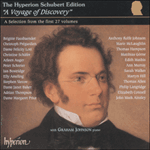
Welcome to Hyperion Records, a British classical label devoted to presenting high-quality recordings of music of all styles and from all periods from the twelfth century to the twenty-first.
Hyperion offers both CDs, and downloads in a number of formats. The site is also available in several languages.
Please use the dropdown buttons to set your preferred options, or use the checkbox to accept the defaults.

The poem of course is imitative of some of Goethe's ideas (most young amateur poets were inspired by the master's verses) and it is hardly surprising that the composer chooses the same key and a somewhat similar accompanying figure for Bruchmann's lakeside scene as for Goethe's Auf dem See. Kreissle's (disputed) date for the Bruchmann song is March 1817, the very same month that Schubert made a copy for Joseph Hüttenbrenner of the Goethe piece which had obviously become a favourite with the circle. In the world of the Schubertiads, ideas bounced off each other; one good song was capable of leading to another (cf. the relationship of Der Tod un das Mädchen to Josef von Spaun's Der Jüngling und der Tod). There is a school of thought however that places Am See much later (1822/23 along with the other Bruchmann settings) although Reed concedes that the earlier date is more likely on stylistic grounds.
As in the Goethe Auf dem See, the introduction depicts an oar cleaving the water; the phrasing and the crescendi to the middle point of the bar suggest that the pianist is rowing, albeit in somewhat languid fashion. The singer has a harder time, for this must be one of Schubert's most technically daunting songs from the point of view of its span – there is no chink in the vocal line and she must take time to draw breath in one of various places, none of them ideal. There are a number of highly effective melismas: these suggest the wondering gaze of poet and singer as the vocal line sweeps the heavens taking in all the beauties in its path. Once the composer has used up all the words of this short poem he repeats the opening and the seventh lines in a type of rapturous accompanied cadenza of cascading melody. The outburst of gratitude on the penultimate 'ach, gar viele' takes us up to a G, the highest note in the piece, a phrase which seems to overflow with emotion. The coda is no less extraordinary; there are two more separate 'viele' phrases as if the sheer number of stars has defeated the singer's powers of description. A final scale passage of melismas, as hauntingly beautiful as it is technically treacherous, blossoms out of the final 'Sterne' which is held for an entire bar. And then 'viele' twice more. The words have been repeated so much that they no longer matter; they serve only to prolong sighing apoggiaturas of rapture.
Franz von Bruchmann was one of the most fascinating young men in the Schubert circle – certainly one of the richest and best-looking. He came from a well-to-do mercantile family which was ennobled in 1818 and his home became a centre for the Schubertiads and the encouragement of new art. It was the Bruchmann family who were close to such important romantic poets as Friedrich von Schlegel and it is just possible that Schubert met the great man under the Bruchmann roof. Bruchmann also had the means and courage to leave Austria in order to study philosophy with Fichte and Schelling – a course of action that was strictly forbidden by the Austrian authorities who feared that young men would take on revolutionary ideas thanks to foreign influences. While in Erlangen to hear Schelling lecture, Bruchmann became friendly with August von Platen, and it is thanks to him that Schubert set two poems (Die Liebe hat gelogen and Du liebst mich nicht) by the celebrated homosexual aesthete who was doubtless drawn to Bruchmann not only because of his intelligence. Bruchmann was also much in sympathy with Johann Senn, the poet and Tyrolean activist, and was arrested (with Schubert) in 1820 when Senn was exiled and the entire circle came under suspicion. Bruchmann was also close to Franz von Schober who was secretly engaged to his sister Justina. After Schubert's illness in 1823 the whole circle began to break up, and Bruchmann moved in other directions; his anti-catholic free-thinking pantheistic youth yielded to ultra-conservative middle and old age. By 35 he had briefly and unhappily married; after the death of his wife he became a Roman Catholic priest in the redemptorist order and founded a new community in Bavaria. Bruchmann broke from all the friends of his early years and even came to renounce poets like Goethe. There are few people who knew more about the Schubertians in their great days but, like Schober, in later life he always declined to answer questions about his friendship with the composer. His poems were never published and he lives on only in the five of his works set by Schubert, and in the contemporary drawings of Kupelwieser.
from notes by Graham Johnson © 1993
 Schubert: The Complete Songs Schubert: The Complete Songs‘This would have been a massive project for even the biggest international label, but from a small independent … it is a miracle. An ideal Christ ... ‘Please give me the complete Hyperion Schubert songs set—all 40 discs—and, in the next life, I promise I'll "re-gift" it to Schubert himself … fo ...» More |
 Schubert: An introduction to The Hyperion Schubert Edition Schubert: An introduction to The Hyperion Schubert Edition'Irresistible!' (BBC Music Magazine) 'A delightful sampler' (The Penguin Guide to Compact Discs)» More |

